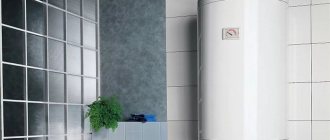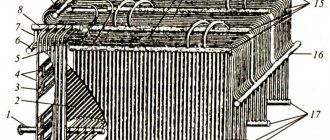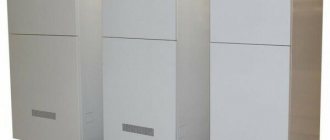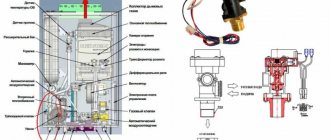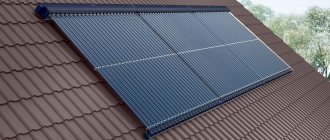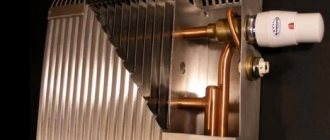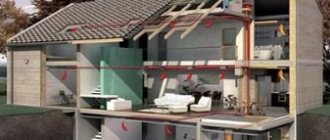Good day, my dear readers! In my articles I often mention the word heating element, but I haven’t really said anything about them anywhere yet. This defect needs to be corrected!
That’s why I decided to write this article, in which I will give a brief educational program on this (quite extensive) topic.
And in one of the following articles I will tell you how to connect heating elements to an electric boiler.
I will say right away that I do not pretend to be a complete review and will be glad to see your comments and observations, on the basis of which it will be possible to supplement this article. So let's start with the definition.
What is TEN?
What is it?
TEN (short for tubular electric heater) is the simplest electric heating device that has a wide variety of applications:
- Heating - heating elements are used as heaters in electric boilers, electric sauna heaters, oil radiators, and so on.
- Hot water supply - storage and instantaneous water heaters heat water using heating elements. And ordinary household kettles also have a heating element installed.
In general, the scope of application of such devices is very wide.
Wherever you need to heat something, you can think about using one or another type of heating element.
Now let's take a closer look at the main types of tubular electric heaters:
- Heating elements for heating liquids - most often, with the help of such devices, water is heated for certain purposes, but there are exceptions to this rule. For example, there are models designed for heating machine oil or food products.
- Heating elements for heating air - it is clear that such devices heat the air, but there are some nuances here - the presence or absence of blowing and the speed of the blowing air. In addition, air heating elements can be equipped with fins, which increase their surface area.
Recommendations for use
The operating rules for the water heater suggest turning off the hot water riser, after which you need to open the taps on the water heater and turn on the power supply. Turning off the boiler involves turning off the power, after which you need to turn off the taps on the water heater and open the hot water riser. When bathing, the water should be turned on and off as needed. It is not recommended to let hot water flow continuously.
In case of prolonged non-use, as well as in the process of carrying out repair and any preventive work related to the water supply line, it is necessary to close the individual shut-off valves located on the cold water supply line and on the hot water supply line, and also be sure to turn off the water heating equipment and disconnect it from electrical networks.
Heating element device
To understand how a tubular electric heater works, look at the figure below:
Water heater heating element device
- The shell is a metal tube. Copper, steel or aluminum tubes of different diameters are used as shells.
- Contact rod - a metal rod with a thread at the end through which the power supply of the heating element is connected.
- The heating element is a spiral made of an alloy with high resistivity.
- Filler - the dielectric periclase (white magnesium oxide powder) is used as a filler.
- Sealing material - protects the filler from external moisture and thereby preserves its properties.
- Contact washers and nuts are needed to secure the terminals.
- Insulator - separates the contact rod and the shell of the heating element. Needed to protect against current leakage to the housing.
The figure shows the length parameters. Let's decipher their meaning:
- L is the expanded length of the heater. According to GOST, it is equal to the sum of the lengths of straight and curved sections.
- La - active length. Equal to the length of the heating element.
- Lk is the length of the contact rod. The length of the embedment is standardized and indicated in the marking using a letter.
- Ly is the length of the leakage current path. Special standardized value.
- d is the diameter of the heating element.
Main types of breakdowns
Modern manufacturers have learned to create excellent luxury water heating equipment. It uses gas to operate efficiently and rarely fails. However, even the best gas heaters cannot avoid breakdowns. The list of inevitable malfunctions includes:
- water leaks;
- poor heating of the liquid;
- discharge of power elements;
- weak water pressure;
- lack of gas.
Owners of gas boilers can repair some faults themselves. Anyone can change the batteries in the power supply. It is also easy to eliminate weak water pressure - perhaps excess scale has simply formed in the heat exchanger. To remove it, remove the heat exchanger and rinse thoroughly. For these purposes, you can also use special descaling liquids.
It is not difficult to solve the problem of poor water heating on your own. The main reason for such a malfunction is often contamination of the heat exchanger with soot. The solution to this problem is to remove the mentioned element and remove plaque. If more significant problems occur, you should contact a professional.
Those who have seen enough of the video on YouTube about a homemade gas water heater, which consisted of a coil placed directly on the hob in the kitchen, have probably already dreamed of how they can get a lot of boiling water cheaply. Actually this is not true. Today we will talk about why you should not make a gas water heater with your own hands.
Marking of heating elements: decoding
In order to be able to distinguish some heating elements from others, special markings were developed, fixed by the state standard.
It is applied to the surface using a press and should be located close to the insulator.
Consider, for example, the following marking:
100А13/1.6р220 - 2R30
- The number 100 indicates the unfolded length of the heating element in centimeters.
- The letter “A” in the marking encodes the depth of embedding of the contact rod (I will give the decoding below).
- The number 13 indicates the diameter of the tube in millimeters.
- The number 1.6 indicates the heater power in kW.
- The letter “p” encodes the heated medium (in this case, water and weak solutions of alkalis or acids) and the tube material (carbon steel).
- The number 220 indicates the supply voltage is 220 V.
- Number 2 is the number of the heating element shape (in this case it is U-shaped).
- R30 is the bending radius of the heating element in millimeters.
Now let's decipher the length of the contact rods. Look at the picture below:
Designation of heating elements markings
Now let's move on to the second letter in the marking.
Here is a breakdown of the most popular options:
| Letter | Heated medium | Tube material | Maximum specific power, W/cm2 |
| X | Water or weak solutions of alkalis and acids | Copper or brass | 9 |
| P | Water or weak solutions of alkalis and acids | Carbon steel | 15 |
| J | Water or weak solutions of alkalis and acids | Stainless steel | 15 |
| Z | Fats or oils | Carbon steel | 3 |
| O | Air or other gas mixtures (with blowing) | Carbon steel | 5 |
| S | Air or other gas mixtures (without blowing) | Carbon steel | 2,2 |
Everything is deciphered in more detail in GOST 13268-88.
For air heating elements, the presence or absence of airflow and even the required air speed are specified.
If you use heating elements designed for blowing in calm air, they will quickly burn out due to too high power density.
To complete the review, I will add a picture with the forms. This will help you navigate them more easily:
Types of heating elements
Advantages
Infrared heated floor advantages and disadvantages, main characteristics and installation principle
Compared to open “boilers”, dry structures have many advantages. For example, let's look at just a few of them:
No scale on the heating element
The rate of formation of this unpleasant layer is affected by the quality of the water and the surface area of contact between the heater and the liquid. The harder the water in your area, the faster scale will form. A thick lime layer reduces the quality of water heating, and the operating life of the heating element is reduced.
The dry heating element is protected from such trouble. In this case, direct contact with water does not occur. This means there is no scale on the heater either.
Compact dimensions
A dry heating element is relatively small in size and takes up much less space than its “wet” counterpart. Thus, the size of the storage tank itself is reduced. Most often, manufacturers install two or even three heaters in one device. This allows the consumer to independently regulate the load. If you need to quickly heat a large volume of water, turn on all the heating elements at once and you will get hot water in just a few minutes.
Even if one of the heaters burns out, nothing bad will happen. During the repair period, you will simply use one of the remaining ones and will still be left with hot water.
Excellent performance
This is another advantage of dry heating elements. Since there is practically no scale formation on such a heater, the speed of obtaining hot water increases significantly. In this case, much less electricity is consumed than when heating water with a “wet” heating element.
By itself, each dry heating element installed in a boiler most often has a lower power than a similar option with a “wet” element. But since water heaters of this type usually use several heating elements, the total power will be significantly lower than that of a “wet” tubular heater. And the consumer can decide whether to use it in full or partially.
TOP 3 best water heaters with dry heating elements Timberk
- Timberk SWH FED1 80 V
- Timberk SWH RE15 50 V
- Timberk SWH RED1 100 V
Ease of maintenance
Water heaters with a dry tubular element have one important feature. They are designed in such a way that if the heating element suddenly fails, you don’t even have to drain the water from the tank to replace it. It is enough to unscrew the protective flange, remove the element, inspect or repair it and insert it back.
Long service life
Due to the lack of contact with scale, dry heating elements have a long service life. One such element is enough for an average of 5 years of uninterrupted operation. While boilers with conventional heating elements fail once every 2-3 years. At current prices for components, this allows you to save a lot.
Dry start protection available
Absolutely all models with a dry heater are equipped with a protection system against switching on without water. If there is no water in the heater tank, the system simply will not allow the unit to turn on. Dry start protection will prevent the tubular heater from burning out. Even if for some reason it does not work, the failure will only affect the heating element. Other boiler systems will not be affected.
Variability
Many dry heating elements have a completely identical design. This allows the same element to be used for different tank models. So in case of repair, you will not have problems with components.
No problems with air locks
Water heaters equipped with dry heating elements are not at risk of developing internal air locks. For models with “wet” heaters, this can result in expensive repairs.
See also -
Heating elements for electric heating boilers
Previously, I wrote a separate article on electric boilers, which I also recommend reading.
Well, okay, let's get down to business. Blocks of heating elements are used as heating elements for electric boilers.
They consist of several heaters, which are combined together with a nut.
To make it clearer, look at the picture below:
Heating element block
The nut is available in the following diameters: 1.25 inches, 2 inches and 2.5 inches.
Such a block is sealed using an annular rubber seal (if it is provided structurally) or by winding with thread or FUM tape.
As for the tubes, they can be made of carbon or stainless steel.
Stainless steel is more expensive, but lasts much longer than black steel.
With powers up to 9 kW, units with a supply voltage of 220 V can be installed inside the boilers.
With higher power, units for a three-phase voltage of 380 V are installed in the boilers.
Heater settings
The last step in making an electrode boiler with your own hands is setting it up. To set up and ensure the operation of the heating installation you will need:
- ammeter (current clamp);
- syringe;
- soda or salt;
- container for stirring.
The estimated power of the house heating installation described above is 4 kW. This means the current strength in the electrical circuit should be equal to 18 A (4000 / 220 = 18).
Connect the ammeter to the power wires and turn on the assembled device to the network. Wait a little until the coolant warms up. Most likely, the measuring device will show less current. Add a solution of salt or soda to the coolant through the expansion tank. To prevent boiling, the release of steam or rupture of plastic pipes, it is recommended to stop adding the solution when the ammeter readings are 16 - 17 A.
Here you will learn:
An ion or, as it is also called, electric electrode boiler is a direct-flow water heater that can quickly and efficiently heat liquid. The device is used mainly in dachas or country houses, since it is easy to install and permission for use is not required. The only significant drawback is that it is quite expensive to operate as the main method of heating in an apartment.
Heating elements for water heaters
Now let's move on to heating elements for water heaters. They can be made on a threaded nut (most often 1.25 inches in diameter) or on a flange that is clamped with bolts. Look at the picture below:
Heating element for a water heater on a flange
There are also “dry” heating elements. They are isolated from water in special flasks and manufacturers claim that they are safer than regular ones.
Although all their safety advantages can be negated by installing an RCD that will turn off the power if there is a leakage current greater than 30 mA.
"Dry" heating element
Reasons for failure
The operating life of the heating device does not depend directly on the manufacturer. Anyone can purchase a low-quality part, but even the original one has a limit of strength and wears out over time.
The cause of breakdown is often water hardness . To prevent malfunctions, it is necessary to install special mechanical or chemical filters that soften hardness. This will extend the life of the heater.
It is important to know that failures are caused by untimely replacement of the anode, which protects heating devices from impurities and excess alkali. You can replace the anode for a water heater after checking its wear (checking should be done once or twice a year). If this is not done in a timely manner, the risk of tank or heater failure will increase.
<<< Read more. Magnesium anode in a water heater - what is it? What is it for?
Another cause of failure is caused by low voltage.
With a sharp increase in current strength, the core in the heating element overheats, and this often leads to burnout of the device.
One of the reasons for the breakdown is a faulty thermostat, which promptly sends a signal from the boiler control panel. If a failure occurs, the signal will not arrive on time, and this will lead to overheating of the heating element.
It is important to regularly diagnose the unit to extend its service life and prevent breakdowns.
Features of choice
Choosing a heating element for your boiler can be a daunting task. You will have to take into account:
- boiler model;
- features of water;
- volume of water for heating;
- operating conditions;
- device maintenance.
First of all, you need to rely on the volume of the water heating tank. Today, the most common elements are those designed for 50-60 liters. However, you can choose heating elements that are installed in boilers of 80, 100, 120 l.
Description of the technical characteristics of the electric heater
The description of the technical characteristics is located at a distance from the beginning of the tube, usually more than 7 cm. The quality of the marking is one of the confirmations of the quality of the product. On a fake, as a rule, it is not there or the inscription is illegible and crooked. The text should be smooth, clear, and easily readable.
For trusted manufacturers, the labeling should not raise doubts, since before this, the products are repeatedly tested for quality and compliance with the declared characteristics. However, if you still want to check the accuracy of the specified characteristics, for example, the heater power, measure the resistance on the contacts using a multimeter. Using the result obtained, find the power using the formula:
U2/R,
where U is the available voltage, R is the resistance.
